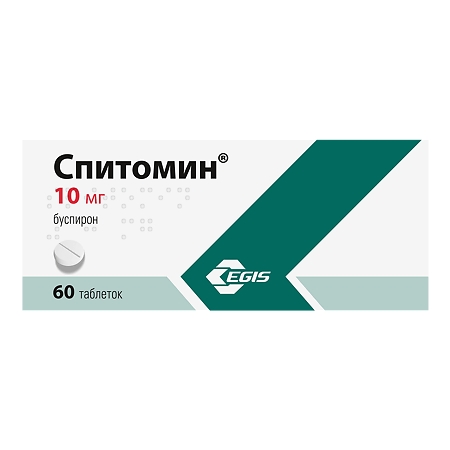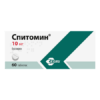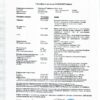No products in the cart.
Spitomine, tablets 10 mg 60 pcs
€29.24 €24.37
Out of stock
(E-mail when Stock is available)
EAN: 5995327262185
SKU: 229826
Categories: Medicine, Neurology and Psychiatry, Sedatives and hypnotics
Description
Spitomine has an anxiolytic, antidepressant effect.
Pharmacodynamics
Anxiolytic (tranquilizing) agent of the non-benzodiazepine series, also has antidepressant effect. Unlike classical anxiolytics it does not have antiepileptic, sedative, hypnotic and muscle relaxant effects.
The mechanism of action is associated with the effect of buspirone on serotonergic and dopaminergic systems. It selectively blocks presynaptic dopamine receptors and increases the rate of excitation of midbrain dopamine neurons. In addition, buspirone is a selective partial agonist of 5-HT1A-serotonin receptors. Buspirone has no significant effect on benzodiazepine receptors and does not affect GABA binding, has no negative effect on psychomotor functions, does not cause tolerance, drug dependence and withdrawal syndrome. It does not potentiate the effects of alcohol. In terms of anxiolytic activity buspirone is approximately equal to benzodiazepines.
Therapeutic effect develops gradually and is noted in 7-14 days from the beginning of treatment, the maximum effect is registered after 4 weeks.
Pharmacokinetics
Buspirone is rapidly and almost completely absorbed from the gastrointestinal tract after oral administration.
Buspirone undergoes intensive first-pass metabolism through the liver. Therefore, the unchanged substance is found in the systemic bloodstream at low concentrations, which have significant individual differences. Bioavailability is 4%. Cmax in plasma is reached 60-90 min after drug administration. In healthy volunteers, buspirone had linear (dose-proportional) pharmacokinetics after 10-40 mg administration. Similar pharmacokinetic parameters were found in elderly patients. After a single oral dose of 20 mg of the drug, its plasma levels are 1 to 6 ng/ml. Approximately 95% of buspirone binds to plasma proteins (86% to plasma albumin, the remainder to α1-acid glycoprotein).
Buspirone undergoes oxidative metabolism, mainly with the participation of CYP3A4 isoenzymes. Various hydroxylated metabolites are formed. The main metabolite (5-ON-buspirone) is inactive. The dealkylated metabolite, (1-(2-pyrimidinyl)-piperazine, 1-PR), is active. Its anxiolytic activity is 4-5 times lower than that of the parent substance, but its plasma levels are higher and the T1/2 is approximately 2 times longer than that of buspirone. After a single administration of 14C-labeled buspirone, 29-63% of the radioactivity is excreted in the urine within 24 hours, mostly in the form of metabolites. Approximately 18-38% of the administered dose is excreted in the feces. After a single dose of 10-40 mg, the T1/2 of the parent substance is approximately 2-3 hours, and the T1/2 of the active metabolite is 4.8 hours.
Concomitant ingestion slows absorption of buspirone, but due to decreased pre-systemic clearance (first pass effect), the bioavailability of buspirone is significantly increased. After intake with food, the AUC of buspirone is increased by 84% and its Cmax by 16%.
The Css in plasma can be reached about 2 days after starting regular dosing.
The apparent Vd is 5.3 L/kg.
Buspirone is excreted in breast milk, but there are no data on placental transmission.
Elevated plasma levels of buspirone and AUC values and prolongation of T1/2 may be observed in hepatic dysfunction. Due to excretion of unchanged substance into bile, a second peak in plasma concentration of buspirone is possible. Patients with cirrhosis should prescribe the drug in lower doses or in the same doses with prolonged intervals.
In renal insufficiency, the clearance of buspirone may be reduced by 50%. In renal failure, buspirone should be administered with caution and in reduced doses.
The pharmacokinetics of buspirone are not altered in elderly patients.
Indications
Indications
generalized anxiety disorder (GAD);
panic disorder;
autonomic dysfunction syndrome;
alcohol withdrawal syndrome (as an auxiliary therapy);
depressive disorders – auxiliary therapy (the drug is not prescribed for monotherapy of depression).
Pharmacological effect
Pharmacological effect
Spitomin has anxiolytic and antidepressant effects.
Pharmacodynamics
An anxiolytic (tranquilizing) non-benzodiazepine drug that also has an antidepressant effect. Unlike classical anxiolytics, it does not have antiepileptic, sedative, hypnotic or muscle relaxant effects.
The mechanism of action is associated with the effect of buspirone on the serotonergic and dopaminergic systems. Selectively blocks presynaptic dopamine receptors and increases the rate of excitation of midbrain dopamine neurons. In addition, buspirone is a selective partial agonist of 5-HT1A serotonin receptors. Buspirone does not have a significant effect on benzodiazepine receptors and does not affect the binding of GABA, does not have a negative effect on psychomotor functions, does not cause tolerance, drug dependence and withdrawal syndrome. Does not potentiate the effects of alcohol. In terms of anxiolytic activity, buspirone is approximately equal to benzodiazepines.
The therapeutic effect develops gradually and is noted after 7–14 days from the start of treatment, the maximum effect is recorded after 4 weeks.
Pharmacokinetics
After oral administration, buspirone is quickly and almost completely absorbed from the gastrointestinal tract.
Buspirone undergoes extensive first-pass metabolism through the liver. Therefore, the unchanged substance is found in the systemic circulation in a small concentration, which has significant individual differences. Bioavailability is 4%. Cmax in blood plasma is achieved 60–90 minutes after taking the drug. In healthy volunteers, buspirone had linear (dose proportional) pharmacokinetics after administration of 10–40 mg. Similar pharmacokinetic parameters were found in elderly patients. After a single oral dose of 20 mg of the drug, its plasma levels range from 1 to 6 ng/ml. Approximately 95% of buspirone is bound to plasma proteins (86% to plasma albumin, the rest to α1-acid glycoprotein).
Buspirone undergoes oxidative metabolism, mainly with the participation of CYP3A4 isoenzymes. Various hydroxylated metabolites are formed. The main metabolite is (5-OH-buspirone) inactive. The dealkylated metabolite – (1-(2-pyrimidinyl)-piperazine, 1-PP) – is active. Its anxiolytic activity is 4–5 times lower than that of the parent substance, but its level in the blood plasma is higher, and T1/2 is approximately 2 times longer than that of buspirone. After a single dose of 14C-labeled buspirone, 29–63% of the radioactivity is excreted in urine within 24 hours, mainly in the form of metabolites. Approximately 18–38% of the administered dose is excreted in the feces. After a single dose of 10–40 mg, T1/2 of the original substance is approximately 2–3 hours, and T1/2 of the active metabolite is 4.8 hours.
Concomitant food intake slows down the absorption of buspirone, but due to a decrease in pre-systemic clearance (first pass effect), the bioavailability of buspirone is significantly increased. After administration with food, the AUC value of buspirone increases by 84%, and its Cmax by 16%.
Css in blood plasma can be achieved approximately 2 days after the start of regular use.
The apparent Vd is 5.3 l/kg.
Buspirone is excreted into breast milk, but there are no data on placental transmission.
Elevated buspirone plasma levels and AUC values, as well as T1/2 prolongation, may occur in patients with impaired liver function. Due to the release of unchanged substance into the bile, a second peak in the concentration of buspirone in the blood plasma is possible. Patients with liver cirrhosis should be prescribed the drug at lower doses or at the same doses at extended intervals.
In renal failure, buspirone clearance may be reduced by 50%. In case of renal failure, buspirone should be prescribed with caution and in reduced doses.
The pharmacokinetics of buspirone in elderly patients is not changed.
Special instructions
Special instructions
Liver failure. Buspirone undergoes extensive metabolism in the liver. A single 30 mg dose in patients with cirrhosis increases plasma buspirone levels and increases AUC with prolongation of the drug’s T1/2 duration. Due to the release of unchanged substance into the bile, a second peak in the concentration of buspirone in the blood plasma is possible. The drug is contraindicated in patients with severe liver failure. Patients with liver cirrhosis should be prescribed the drug at lower doses or at the same doses at extended intervals.
Kidney failure. In moderate or severe renal impairment, buspirone clearance may be reduced by up to 50%. The drug is contraindicated in patients with severe renal failure with GFR less than 10 ml/min. In mild (GFR greater than 30 ml/min) and moderate (GFR 10–30 ml/min) renal failure, buspirone can be used, but caution should be exercised and reduced doses should be prescribed.
Elderly patients. Old age in itself does not require dose adjustment, but caution is recommended (for example, due to a possible decrease in renal and/or liver function and an increased likelihood of side effects). Patients should be prescribed the lowest possible effective dose, and if the dose is increased, the patient should be closely monitored.
The use of the drug requires special caution in patients with rectangular glaucoma and myasthenia.
In case of lactose intolerance, when preparing a diet, the lactose content in the tablets should be taken into account (55.7 mg in 5 mg tablets and 111.4 mg in 10 mg tablets).
Patients should be advised not to eat grapefruits or drink grapefruit juice in significant quantities, because these products may increase plasma levels of buspirone and result in an increase in the frequency or severity of side effects.
Transferring patients from benzodiazepines to buspirone. Buspirone cannot reverse benzodiazepine withdrawal symptoms. If a patient is switched to buspirone after long-term benzodiazepine therapy, buspirone should be initiated only after a period of benzodiazepine tapering has been completed.
Buspirone does not cause addiction to the drug, but its administration to patients with an established or suspected predisposition to drug dependence requires careful medical supervision.
Since the anxiolytic effect appears after 7–14 days of taking the drug, and the full therapeutic effect develops in approximately 4 weeks, patients with severe anxiety require careful medical supervision during the initial period of therapy.
During the entire course of treatment with buspirone, you should avoid drinking alcoholic beverages.
Impact on the ability to drive vehicles and operate machinery. The results of clinical studies showed that buspirone monotherapy does not affect the psychomotor performance of patients. Despite this, at the beginning of the course of treatment, transient undesirable effects are possible, and therefore patients should be warned that driving vehicles and operating machinery is possible only if the patient is fully confident in his psychomotor functions. The patient’s ability to drive vehicles and operate machinery should be determined individually, depending on the patient’s response to treatment and the use of concomitant therapy.
Active ingredient
Active ingredient
Buspirone
Composition
Composition
1 tablet contains:
active ingredient:
buspirone hydrochloride 10 mg,
excipients:
lactose monohydrate 111.4 mg;
MCC;
sodium carboxymethyl starch;
magnesium stearate;
silicon dioxide colloidal anhydrous
Pregnancy
Pregnancy
Due to the lack of properly controlled clinical trial data, the use of buspirone during pregnancy is only possible if the benefits of the drug justify the possible risks. Women of childbearing potential should use adequate contraception during treatment with buspirone, since the safety of buspirone during pregnancy has not been proven.
Buspirone is excreted into breast milk. There are no sufficient data from clinical studies of the use of buspirone during breastfeeding, therefore nursing mothers are not recommended to take this drug.
Contraindications
Contraindications
hypersensitivity to any component of the drug Spitomin;
severe renal failure (glomerular filtration rate (GFR) below 10 ml/min);
severe liver failure (PT – more than 18 s);
simultaneous use of MAO inhibitors or a 14-day period after discontinuation of an irreversible MAO inhibitor, or 1 day after discontinuation of a reversible MAO inhibitor;
glaucoma;
myasthenia gravis;
lactation;
pregnancy or suspected pregnancy;
age under 18 years (the safety and effectiveness of buspirone for this age group have not been proven).
With caution: liver cirrhosis, renal failure.
Side Effects
Side Effects
Buspirone is usually well tolerated. Side effects, if observed, usually occur early in the course of treatment and then disappear despite continued use of the drug. In some cases, a dose reduction is necessary.
To determine the frequency of side effects of the drug, the following classification is used: often (more than 1/100); uncommon (from 1/100 to 1/1000); rare (less than 1/1000); very rare (< 1/10000) (in many cases, in the absence of a comparator drug, the relationship of undesirable effects with taking the drug could not be proven).
From the cardiovascular system: often – chest pain; infrequently – fainting, hypotension, hypertension; rarely – cerebrovascular accidents, decompensation of heart failure, myocardial infarction, myocardiopathy, bradycardia.
From the side of the central nervous system: often – dizziness, headache, increased nervous excitability, sleep disturbances; uncommon – dysphoric reactions, depersonalization, dysphoria, increased sensitivity to noise, euphoria, hyperkinesis, fear, apathy, hallucinations, confusion, prolonged reaction time, suicidal thoughts, epileptic seizures, paresthesia, impaired coordination of movements, tremor; rarely – claustrophobia, cold intolerance, stupor, stuttering, extrapyramidal disorders, psychotic disorders.
From the organs of vision and hearing: often – tinnitus, laryngitis, swelling of the nasal mucosa; infrequently – blurred vision, itching in the eyes, redness of the eyes, conjunctivitis, impaired taste and olfactory sensations; rarely – inner ear disorders, eye pain, photophobia, increased IOP.
From the endocrine system: rarely – galactorrhea and damage to the thyroid gland.
From the gastrointestinal tract: infrequently – nausea, flatulence, anorexia, increased appetite, salivation, intestinal bleeding; rarely – diarrhea, burning sensation in the tongue.
From the genitourinary system: infrequently – dysuric disorders (including frequent urination, urinary retention), menstrual irregularities, decreased libido; rarely – amenorrhea, pelvic inflammation, bedwetting, delayed ejaculation, impotence.
From the musculoskeletal system: infrequently – muscle spasms, muscle rigidity, arthralgia; rarely – muscle weakness.
From the respiratory system: infrequently – hyperventilation, lack of air, feeling of heaviness in the chest; rarely – nosebleeds.
Skin: uncommon – swelling, itching, hot flashes, hair loss, dry skin, facial swelling, skin tenderness, rash.
Other: weight gain, fever, weight loss, muscle and bone pain; rarely – alcohol abuse, loss of voice, tinnitus, hiccups.
Changes in laboratory parameters: infrequently – increased levels of ALT and AST in blood serum; rarely – eosinophilia, leukopenia, thrombocytopenia.
Interaction
Interaction
Considering the pharmacokinetic properties of the drug (low bioavailability, intensive metabolism in the liver, high protein binding), there is a high probability of interaction of buspirone with simultaneously administered drugs; however, because buspirone has a significant therapeutic breadth, pharmacokinetic interactions do not result in clinically significant pharmacodynamic changes.
MAO inhibitors (MAOIs). An increase in blood pressure and the occurrence of hypertensive crises have been described after the simultaneous administration of buspirone and drugs acting on MAO (moclobemide, selegiline); therefore, buspirone should not be combined with MAOIs. After discontinuation of an irreversible MAOI (for example, selegiline), at least 14 days must pass before starting administration of Spitomin® (and vice versa). Likewise, at least 14 days must pass after discontinuation of the drug Spitomin® before starting the administration of moclobemide (a reversible MAOI). However, Spitomin® can be given 1 day after discontinuation of moclobemide.
CYP3A4 inhibitors and inducers. In vitro studies have shown that buspirone is primarily metabolized by cytochrome P450 isoenzymes CYP3A4. Concomitant administration of buspirone and CYP3A4 inhibitors (erythromycin, itraconazole, nefazodone, diltiazem, verapamil and grapefruit juice) may lead to drug interactions, and the administration of a strong inhibitor may also increase plasma levels of buspirone; therefore, it is necessary to reduce the dose of buspirone (for example, to 2.5 mg 2 times a day).
Strong inducers of CYP3A4 (eg rifampicin) may significantly reduce buspirone plasma levels and reduce its pharmacodynamic effects.
Drugs that are highly protein bound. Since buspirone is highly protein bound (95%), there is always the possibility of interaction with other protein-bound active substances. In vitro studies have shown that buspirone cannot displace highly bound drugs (warfarin, phenytoin, propranolol) from proteins, but can replace weakly bound drugs, such as digoxin.
When cimetidine is coadministered with buspirone, the Cmax of buspirone increases by 40%, but its AUC does not change. Coadministration of these drugs requires close medical supervision.
When diazepam is co-administered with buspirone, the level of nordiazepam increases slightly, and side effects may occur: systemic dizziness, headache, nausea.
CNS depressants and alcohol. Coadministration of buspirone with triazolam or flurazepam does not increase the duration or strength of the effect of these benzodiazepines. After a single dose of 20 mg of buspirone, its effects on the central nervous system are not enhanced. There is insufficient experience with the combined use of buspirone and other anxiolytics or other drugs acting on the central nervous system (for example, antipsychotics and antidepressants). Therefore, in such cases, careful medical supervision is necessary.
Other drugs. Due to the lack of relevant clinical data, the combined use of buspirone with antihypertensive drugs, cardiac glycosides, oral contraceptives and antidiabetic agents is possible only under conditions of careful medical supervision.
Overdose
Overdose
Symptoms: gastrointestinal disorders, nausea, vomiting, dizziness and drowsiness; depression of consciousness of varying degrees of severity (in severe forms).
Treatment: gastric lavage and symptomatic therapy. Dialysis is ineffective.
Experience to date suggests that even extremely high doses (single oral administration of 375 mg) do not necessarily cause severe symptoms.
Storage conditions
Storage conditions
In a place protected from light, at a temperature not exceeding 30 °C.
Shelf life
Shelf life
5 years.
Manufacturer
Manufacturer
EGIS, Hungary
Additional information
| Shelf life | 5 years. |
|---|---|
| Conditions of storage | In the dark place at a temperature not exceeding 30 °C. |
| Manufacturer | EGIS, Hungary |
| Medication form | pills |
| Brand | EGIS |
Related products
Buy Spitomine, tablets 10 mg 60 pcs with delivery to USA, UK, Europe and over 120 other countries.













